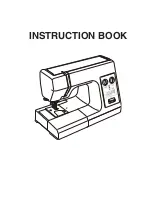
38
Adjusting the Needle Thread Tension
Choosing the Correct Tension - Straight Stitch
The ideal straight stitch will have threads locked
between the two layers of fabric.
According to the LCD screen, needle thread tension
can range from 2 – 6
q
and is normally set on 4.
Align the number 4 on the tension dial with the
setting mark
w
.
If you look at the needle thread
e
(top thread) and
bobbin thread
r
(bottom thread), you will notice
that there are no gaps. Each stitch is smooth and
even.
Occasionally the needle thread tension needs to be
adjusted. Examples:
— stiff or heavy fabric
— sewing more than two layers of fabric
— type of stitch
— thread
When adjusting needle thread tension, the higher
numbers tighten, the lower numbers loosen.
q
w
e
r
• Tension is too tight
The bobbin thread shows through on the topside of
the fabric and it will feel bumpy.
Turn the dial to a lower number to loosen the needle
thread tension.
• Tension is too loose
The needle thread shows through on the underside
of the fabric and it will feel bumpy.
Turn the dial to a higher number to tighten the
needle thread tension.
• Adjusting Tension for Zigzag and Satin Stitches
The upper thread tension should be slightly looser
when sewing a zigzag or a satin stitch. The upper
thread should appear slightly on the underside of
the fabric.















































